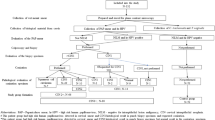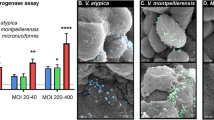Abstract
The risk of cancer of the cervix is linked with sexual behaviour. Although infectious agents such as human papillomaviruses (HPVs) are implicated, these alone may be insufficient to induce the disease. We have investigated the potential role of oxidation products of the polyamines spermine and spermidine and the diamine putrescine in seminal plasma (SP) as co-factors in the development of cervical cancer. These amines are oxidised by polyamine oxidase (PAO) and diamine oxidase (DAO) to generate oxygen radicals and hydrogen peroxide, reactive aldehydes and acrolein, which are likely to exert local mutagenic, cytotoxic and immunosuppressive effects in vivo. Using a chemiluminescence assay, we determined the levels of these amines in 187 samples of SP. Spermine plus spermidine, as substrates for PAO, were present in a range equivalent to 0-4.8 mg ml-1 spermine. Putrescine, as a substrate for DAO, was detectable in only 4 of 40 samples assayed (range 0-168 micrograms ml-1) and constitutes a minor component of the oxidisable content of SP. Cervical mucus (126 samples) was assayed for the presence of PAO and DAO. Both enzymes were present in 14.3% of the samples, PAO only in 21.4%, DAO only in 15.1% and neither enzyme in 49.2%. PAO levels ranged from 0 to 0.828 pmol peroxide generated min-1 mg-1 mucus and DAO levels ranged from 0 to 7.0 pmol peroxide generated min-1 mg-1 mucus. These results suggest that sexual activity in the absence of physical barrier contraception may lead to the generation of mutagenic and immunosuppressive polyamine oxidation products within the female genital tract. We thus propose that women with high levels of PAO and/or DAO in their cervical mucus may be at increased risk of cervical cancer, especially if the male partner's SP shows high polyamine levels. HPV infection may synergise with the effects of polyamine oxidation by suppressing apoptosis in keratinocytes carrying potentially oncogenic mutations, leading to the survival and proliferation of transformed cells in the cervix.
This is a preview of subscription content, access via your institution
Access options
Subscribe to this journal
Receive 24 print issues and online access
$259.00 per year
only $10.79 per issue
Buy this article
- Purchase on Springer Link
- Instant access to full article PDF
Prices may be subject to local taxes which are calculated during checkout
Similar content being viewed by others
Author information
Authors and Affiliations
Rights and permissions
About this article
Cite this article
Fernandez, C., Sharrard, R., Talbot, M. et al. Evaluation of the significance of polyamines and their oxidases in the aetiology of human cervical carcinoma. Br J Cancer 72, 1194–1199 (1995). https://doi.org/10.1038/bjc.1995.485
Issue Date:
DOI: https://doi.org/10.1038/bjc.1995.485
This article is cited by
-
Properties of recombinant human N1-acetylpolyamine oxidase (hPAO): potential role in determining drug sensitivity
Cancer Chemotherapy and Pharmacology (2005)
-
Polyamines
Molecular Biotechnology (1999)



